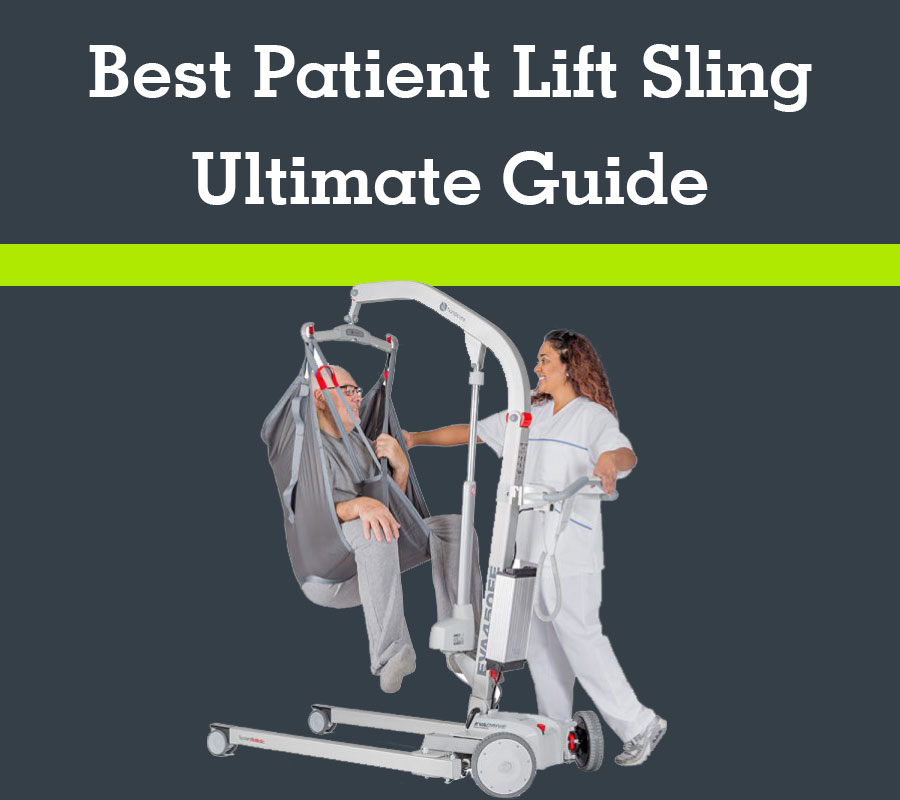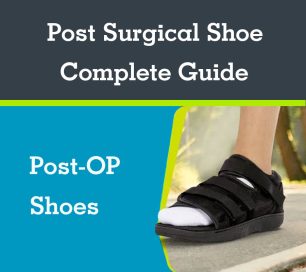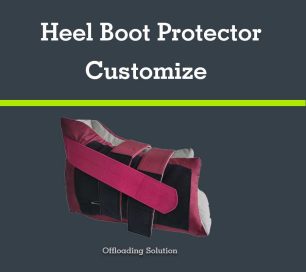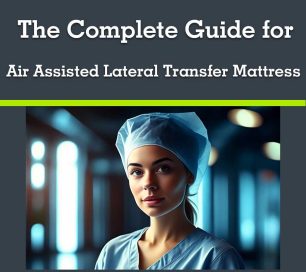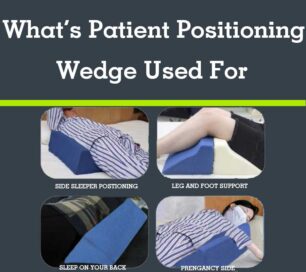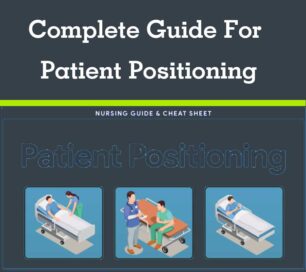Last Updated on 2 years by admin
This guide will provide you with everything you need to know about slings, to help you find the right sling for you or your loved one’s needs. along with recommendations for the best products to fit your needs.
If you use a patient lift, a sling is an important accessory attached to the lift to help safely and comfortably transfer you from one place or position to another. The sling supports your weight and provides stability, making transfers safer for a patient and caregiver.
How to Choose the Best Patient Lift Sling
Choosing the right / best patient lifting sling for your client is very important in ensuring that they are as comfortable and supported as possible. But there are loads of different slings in loads of different sizes – so which should you choose?
Here’s a brief guide to some of the most common patient lifting slings and what they are used for.
- Lift Compatibility
- Types Of Patient Lifting Slings
- Getting The Right Patient Lifting Sling Size
- Material Of Patient Lifting Slings
- Weight Capacity
These are the main things you need to consider when choosing a patient lifting sling. what the sling is made of? lift compatibility, weight capacity, Getting the right style and size of sling is key to ensure that the patient is comfortable and well-supported.
Patient Lift Slings Customized Service
With over one million slings manufactured worldwide, Metacare offers a comprehensive line of styles, sizes and materials that can be used with most ceiling or floor lifts. We also offer options for users that require a customized solution.
We believe that empowering movement within healthcare environments is essential to quality care. Our products and solutions are designed to promote a safe and dignified experience through patient handling, personal hygiene, and the prevention of pressure injuries
Multi-Purpose Seated Transfer Sling
The most commonly supplied patient lift sling for general transfer purposes.
Seated Transfer Sling for Toileting
Specifically designed for toileting and hygiene functions.
Walking Support Slings
Offers upper body support and freedom of movement to assist in ambulation, gait training and fall prevention.
Sit to Stand Transfer Sling
For use with sit-to-stand lifts, our slings give gentle and comfortable support while raising to a standing position.
Specialty Slings
For niche needs and unique situations, Metacare offers a variety of specially designed slings.
-
Product on sale
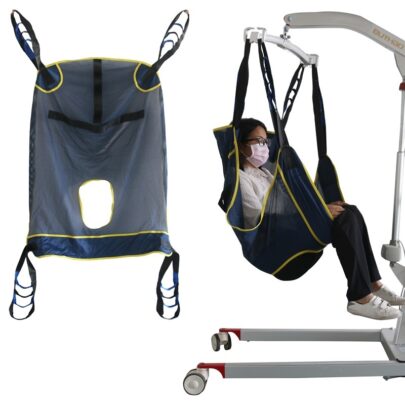 Hoyer Lift Sling For Toileting
Hoyer Lift Sling For Toileting -
Product on sale
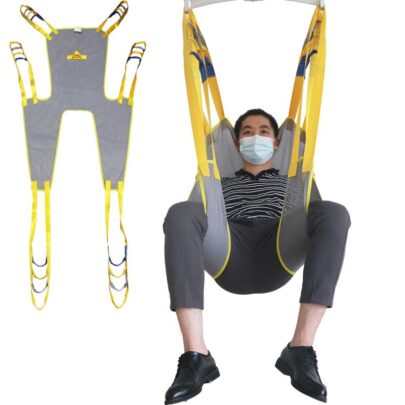 Full Body Divided Leg Mesh Patient Lift Sling
Full Body Divided Leg Mesh Patient Lift Sling -
Product on sale
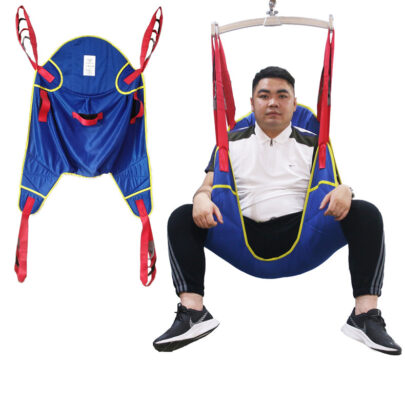 Padded U Patient Lift Sling with Head Support
Padded U Patient Lift Sling with Head Support -
Product on sale
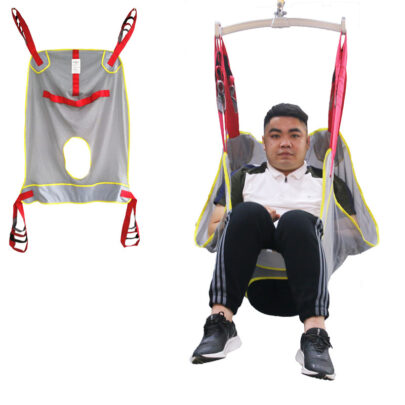 Full Body Mesh Patient Lift Sling Commode Opening
Full Body Mesh Patient Lift Sling Commode Opening -
Product on sale
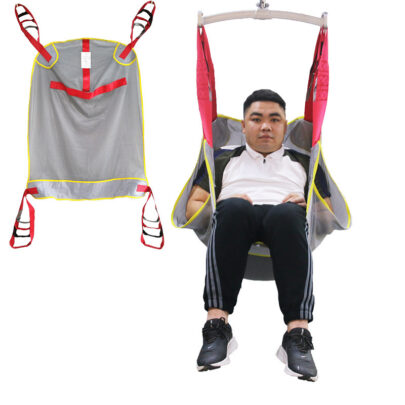 Full Body Divided Leg Mesh Patient Lift Sling
Full Body Divided Leg Mesh Patient Lift Sling -
Product on sale
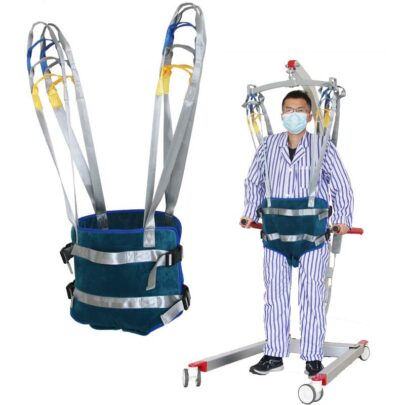 Walking Sling For Patient Lift
Walking Sling For Patient Lift
Contact US Now For Customized Service
What is a patient lift sling?
A patient lift sling is part of a lift system to transfer someone from one place to another.
Slings are straps or belts that are designed to wrap around a patient’s body who is mobility impaired or disable comfortably and are considered to be an essential part of any patient’s lift to ensure a safe and comfortable transfer for both patients and caregivers.
These devices serve the essential role of holding and supporting patients as they are moved or transferred from surface to surface!Slings wrap under and around patients who will be repositioned by a patient lift.This could include moving a patient from a wheelchair to a bathtub or from a bed to a chair. They can also be useful in picking up someone from the floor who has had a fall or transfer a patient to or from toilet, or shower.By lifting the patient completely with no manual exertion on behalf of their caregiver, risks and injuries are significantly reduced for both parties.
Slings come in different types and designs to meet a variety of patient’s needs and sizes. and could be very challenging sometimes to decide which sling is the right fit for your need.
Before purchasing a patient lift sling you should take into considerations the following.
Features to Consider Before Purchasing
Transfer task – patient lift sling Applications
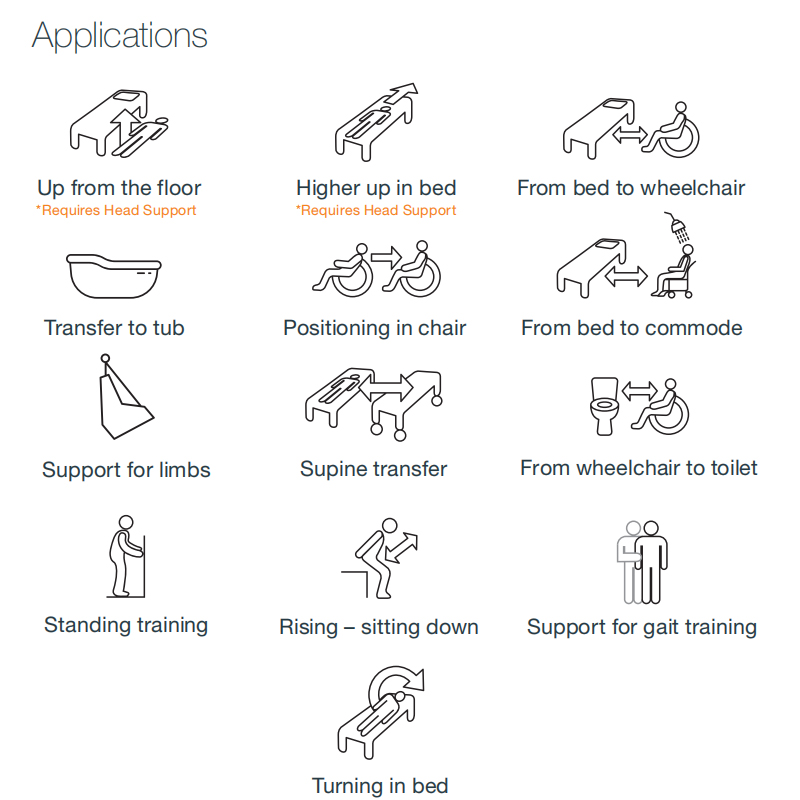
- Up from the floor
- Higher up in bed
- From bed to wheelchair
- From bed to commode
- From wheelchair to toilet
- Transfer to tub
- Positioning in chair
- Support for limbs
- Rising – sitting down
- Standing training
- Support for gait training
- Turning in bed
- Supine transfer
Material
A patient’s weight, stability, muscle tone, and where they will be transferred to and from play a role in choosing the correct sling material.
Mesh

Easy to clean, dries quickly, and great for use in the bathroom with commode or bathing slings. Suitable for patients who have the potential to get wet.
- Highly durable, open-weave polyester blend
- Manufactured for strength
- Mesh slings have quick drying properties and are highly breathable
- Slings made of this fabric are washable Polyester Mesh (Mesh / Poly)
- Polyester mesh is combined with smooth polyester layer and non-absorbent padding on inner leg sections
- Ideal for use in swimming pools and for showering while the sling is in position
Polyester (Poly)

Durable, easy to clean, breathable, washable, and useful in wet or dry environments. Suitable for heavy duty institutional use as they are easy to keep clean, eliminating cross contamination and fostering a healthy environment.
- Highly durable, closed weave fabric manufactured for strength
- Slings made of this fabric are washable and have an anti-microbial coating
- Some of our Polyester slings offer open-cell foam padding in the leg supports and optional head supports.
Polyester SlipFit (PolySlip)

- Smooth knitted polyester fabric that can stretch providingease of application and added comfort
- Includes outer leg sections of ‘slip fit’ nylon material with low friction properties allowing it to be fitted / removed more easily
Spacer

- Multi-directional stretch
- Wicks away moisture
- May be suitable for those with skin integrity issues
- May provide a more comfortable fit for those in pain
Polyester Mesh (Mesh / Poly)

- Polyester mesh is combined with smooth polyester layer and non-absorbent padding on inner leg sections
- Ideal for use in swimming pools and for showering while the sling is in position
Quilted Mesh (Quilted)

- Our Quilted Mesh fabric slings have a unique blend of quilted open cell foam and polyester that provides increased comfort for users and reduces bunching under the legsm
- Highly durable and constructed to be permeable, allowing for air and water to pass through
- Easily washable when needed
- Seated style transfers slings have the body of Mesh material and the leg supports of Quilted Mesh material
Disposable

Single use. Suitable when extra high hygiene standards are required to be met.
- Designed for single patient use, this non-woven, stitch-bond polyester is strong, highly breathable, and liquid repellent
- Can be spot cleaned of light soiling; disposable fabric slings are designed to be left in place
- Premium version includes padded leg and head support,increased SWL, and ability to position user in sling
Padded – with Anti-Microbial Coating

Extra padding for comfort. Suitable for patients with sensitive skin or issues like pressure ulcers.
- Padded polyester leg bands with increased comfort
Compatibility With Your Device
Patient lifts come with a range of between 2 and 12 attachment points. Although many slings are universally compatible with patient lifts according to the number of attachments, there are some lifts that require patient slings that are model-specific. Do not assume every sling will fit every lift.
Patient’s size, weight, and hip measurement
It’s very important to evaluate your patient’s size and weight before purchasing a sling, as each sling comes with a different weight capacity and measurements. choosing the appropriately sized sling will improve the patient’s safety and comfort during the lift and reduce the risk of falling.
All of our slings come with specifications to provide customers with an explanation of the recommended height and weight, so no need to wonder!
Weight limit
Because bariatric patients sometimes need the assistance of a patient lift sling, it’s important to check the weight capacity of a sling to ensure a safe and secure user experience.
Size of Sling
The four areas to measure to correctly size a patient lift sling are patient height, waist size/shoulder size, thigh size, and the manufacturer’s weight recommendation. Generally, always fit the sling to the largest part of the patient’s body. It is sized correctly if the lower edge is positioned at the patient’s sacrum/coccyx area, the leg straps are comfortably placed under the thighs, and the patient’s shoulders are at the same height of the sling (unless full head support is needed).
Sling Back Size
A low back sling is an alternative to a standard hygiene or bathing sling, with increased support for users with variable body tone, while still providing adequate access to clothing to carry out toileting or bathing.
A medium back sling provides comfortable support for most seated transfers and when properly sized will come up to about the shoulders of the patient. It’s suitable for users who can easily hold up their heads.
For patients who can’t independently hold up their heads, a high back sling provides the comfortable head support necessary to prevent the head from dropping backward.
Patient’s medical condition & Pressure sensitivity
It’s very important to evaluate your patient’s size and weight before purchasing a sling, as each sling comes with a different weight capacity and measurements. choosing the appropriately sized sling will improve the patient’s safety and comfort during the lift and reduce the risk of falling.
All of our slings come with specifications to provide customers with an explanation of the recommended height and weight, so no need to wonder!
Sling Shape & Type of transfer task (patient lift sling Applications)
Patients lift slings come in different shapes and are differently designed based on the requirements of a patient.
The Patience Lift Sling type
Full Body Slings
This hammock-style sling is square shaped, and it supports the entire body, with the patient’s arms inside the sling straps. The patient’s legs, from the knee down, will hang outside the sling. This type of sling typically has a higher back, providing head support. Most of these slings are universal and will work with a variety of patient lifts. They are compatible with chair to chair, bed to chair, floor to bed transfers, and with a commode
| Pros | Cons |
| Offers full body support | Sometimes the shoulder area can be pinched, causing patient discomfort |
| Provides support for the head in case it drops back | The sling can press knees together tightly |
| Most are universal and will work with any patient lift |
U-Shape Sling (Hygiene Sling)
Seated Transfer Sling for Toileting
The U-Shape sling crosses under the patient’s legs and is the easiest to use since it doesn’t go under the patient’s bottom. The sling is open at the bottom for efficient transfers from bed to toilet or wheelchair. They are most often used for bathroom transfers, and often called toilet slings or hygiene slings. This sling is fitted while the patient is lying down, and it can be left under the patient while the toilet is being used. They do not come standard with head support. U-shaped slings are compatible with transfers to and from the toilet, chair to chair, and chair to commode.
- Provide standard back and upper leg support.
- Easier applications for seated users than full body slings.
- Provides support from under the thighs, behind the mid to low back, around the torso
- Includes buckle enclosure
- Divided leg supports that can be applied and removed in a seated position
- Large commode opening
Materials – Quilted
Applications:
- From bed to commode
- From wheelchair to toilet Transfer to tub
| Pros | Cons |
| Open at the bottom for quicker transfers between surfaces | Doesn’t usually provide head support |
| Versatile and suitable for most people | Can cause legs to be spread wider than is comfortable for some users |
| Easiest style to use |
Universal Sling – Multi-Purpose Seated Transfer Sling
Similar to a U-Shape patient lift sling, a universal style crosses under the patient’s legs. This provides stability, ease-of-use for a caregiver, and evenly distributes weight. This decreases the amount of pressure on any single area of the patient’s body and keeps the patient from being pinched in too tightly.
- Provides support around the hips and sacral area and under the thighs up to the shoulders with optional head support
- Generous lateral trunk support
- Multiple loop and strap options can accommodate various seated and semi-reclined positions
- Divided leg supports can be applied and removed in a seated or supine position
- Leg straps can be applied in various positions for different levels of support
- Built-in caregiver handles on each side add an additional level of control when moving and transferring user
- Medium commode opening
Materials:
- Mesh / Poly
- Quilted
- Mesh
- PolySlip
- Spacer
- Padded
- Disposable
- Premium Disposable
Applications:
- Up from the floor
- From bed to commode
- From bed to wheelchair
- Higher up in bed
- Transfer to tub
- Positioning in chair
| Pros | Cons |
| Compatible with most lifts and a wide range of patient conditions | Since it doesn’t support the patient’s bottom, it doesn’t feel like a chair or hammock for the patient and can take some getting used to |
| Easy for the caregiver to position the patient correctly in the sling | |
| Evenly distributes the weight of the user | |
| Comfortable user experience without pressure on any single area of the body |
Stand Aid Sling – Sit to Stand Transfer Sling
This style of patient lift sling is for those who require some assistance and support while using a sit-to-stand lift. It supports the middle and lower part of the body. It is for patients who can stand and bear their own weight, and is attached after they are in a standing position and before the lift is moved. These slings are compatible with transfers to and from the toilet, chair to chair, bed to chair, and chair to commode.
- Designed to provide support for sit to stand transfers, toileting, and standing training
- Provides support from mid to low back, around the torso with velcro and buckle enclosure
- Optional non slip back available with velcro enclosure
Materials – Poly
Applications:
- Standing training
- From bed to wheelchair
- From bed to commode
- From wheelchair to toilet
- Rising – sitting down
- Positioning in chair
| Pros | Cons |
| Easy to use with just two attachment points | Not for use with other kinds of lifts |
| Provides comfortable support while using a sit-to-stand lift | Not all sizes will fit all patients |
| Adds a layer of safety ensuring the patient stays upright and positioned correctly on the lift |
Split Leg Sling
With wide straps that loop through the legs, this design gently separates the patients legs, preventing the knees from being tightly pressed together and helping to more evenly distribute the patient’s weight. This sling is sometimes called a divided leg sling. This sling provides a comfortable user experience and is easy for caregivers to use.
| Pros | Cons |
| Keeps weight distributed evenly | The arms are not tucked in as securely as with the full body sling |
| Prevents knees from knocking or being pushed together | Patients can get a “closed in” feeling from the crossing straps in front of their bodies |
| Comfortable transport position for patients |
(Deluxe) Hammock Sling
Multi-Purpose Seated Transfer Sling
- Provides support around the hips and sacral area and under the thighs up to the shoulders with optional head support
- Multiple loop and strap options can accommodate various seated and semi-reclined positions
- Divided leg supports that can be applied and removed in a seated or supine position
- Leg straps can be applied in various positions for different levels of support
- Built-in caregiver handles on each side add an additional level of control when moving and transferring user
- Small to medium commode opening
Comfort Care Sling
Multi-Purpose Seated Transfer Sling
- Provides support from under the thighs up to the shoulders with optional head support
- Small commode opening is optional
- Available with multiple loop and strap options that accommodate various seated and semi-reclined positions
Materials:
- Mesh / Poly
- PolySlip
- Spacer
- Quilted
Applications:
- Up from the floor
- Higher up in bed
- From bed to wheelchair
- From bed to commode
- From wheelchair to toilet
- Transfer to tub
- Positioning in chair
Dual Access Sling
Seated Transfer Sling for Toileting
- Provides support from under the thighs, behind the mid to low back, around the torso with a Velcro and belt enclosure
- Side retention straps are optional
- Divided, padded leg supports can be applied and removed in a seated position
- Large commode opening
Materials – Poly
Applications:
- From bed to commode
- From wheelchair to toilet
- Transfer to tub
Band Sling
Limb Support Sling
- Designed to assist caregivers in supporting and positioning limbs
- Situations include wound care, foot care, hygiene care, sling application, bed exercises, and general limb elevation
Materials:
- Quilted
- Disposable
Applications – Support for limbs
Positioning Sling
Positioning Sling for Full Body Support
- Provides full body support for lateral supine transfers, repositioning and turning in bed
- Multiple loop and strap options can accommodate various user repositioning and transfer tasks
- Intended to be left in place (assessment required)
- Mesh
- Poly
- Spacer
- Disposable
Applications:
- Supine transfer
- Turning in bed
- Higher up in bed
Tri-Turner Sling
Turning Sling
- Symmetrically designed to assist with turning in either direction in bed
- Velcro straps securely attach to bedframe to prevent sling migration
- Provides access for hygiene care, wound care, offloading, dressing
Materials:
- Mesh
- Poly
- Disposable
Rehab Total Support System
Standing and Walking Support Sling
- Provides support around the torso with dual adjustable Velcro enclosures
- Designed for transfers, standing, gait training and fall prevention
- Padded leg harness is attached to the torso support via adjustable buckle enclosures
Materials: Poly
Applications:
- Support for gait training
- Standing training
- Rising – sitting down
Thorax Sling
Sit to Stand Transfer Sling
- Designed to provide support for sit to stand transfers, toileting, standing training and gait training
- Provides support from the mid to low back around the torso with buckle enclosure
- Optional seat support and arm support are available, fabric dependent
Materials: Disposable
Applications:
- Standing training
- Rising – sitting down
- From bed to commode
- From bed to wheelchair
- From wheelchair to toilet
- Positioning in chair
Specialty Patient Lift Slings
Pediatric Sling
Disabled children may require being lifted and moved several times a day in order to meet their medical needs. Slings specifically sized for a child’s comfort, often decorated with bright non-institutional colors, and often come with full head support and an open bottom to use while toileting.
Bariatric Sling
Bariatric patient slings safely move a larger patient from lying down or a seated position to another location. Additional options for bariatric slings include toilet openings and lifting straps. Some are lift-specific, and others provide a universal fit for any patient lift. View our Bariatric Patient Lift Slings category for more products!
Sling for Patients with Leg Amputee
An amputee sling is designed specifically for the comfort and support of users who have had one or both legs amputated at any point above the knee. If the sling has a commode opening, it’s smaller to allow placement under both legs, and loops prevent them from pulling apart. These slings are often weighted to ensure pressure is distributed evenly to enhance stability.
Sling with Head Support for Weak Neck
For patients who can’t consistently hold their heads up on their own, and are at risk for their head dropping back during a transfer, a high-backed patient sling offers support to the head to keep the patient comfortable and positioned correctly.
Stretcher/Repositioning Sling
A stretcher/repositioning sling is a type of full-body sling that can move patients comfortably and safely while remaining in a supine position during a horizontal transfer. These slings evenly distribute the patient’s weight for maximum comfort.
Walking Harness
When a patient’s therapy, treatment, and rehabilitation includes gait training, a walking harness attached to a lift can be an effective tool. This equipment helps improve balance, gait, and coordination, while safely supporting the patient.
Bathing Sling
A bathing sling allows for removing clothing while sitting in the sling, and is usually made of quick drying mesh material. They come with or without head support, and the bottom and lower back are exposed for bathing or showering. The design of this sling is identical to the hygiene sling, except for being made from water-friendly material to facilitate bathing or showering.
Disposable Sling
Disposable slings are ideal when a high level of hygiene is required. Disposable slings prevent cross contamination. They must be disposed of once soiled and cannot be laundered. Disposable slings are usually purchased by hospitals, but they can be beneficial in homecare settings as well. Disposable slings do have their drawbacks; over time, they will be more costly than reusable slings.
Frequently Asked Questions
Why Do Patients Need Slings?
In many instances, a patient with limited mobility will need the assistance of a patient lift with a sling. These devices help caregivers transfer patients from the bed, to a chair, to a wheelchair and more.
How does a lift sling work?
A patient lift sling wraps around a patient’s body and secures to a patient lift. A sling will gently and safely support the patient as they are transferred from one place to another.
What’s Common Tasks for Slings
In addition to various size and weight recommendations, there are certain slings recommended for specific tasks such as:
- Seat/Back Sling (w/co) – commode to bath, chair to chair, bed to chair, and chair to commode.
- Stand Assist Slings – toilet, chair to chair, bed to chair, and chair to commode.
- Full Body Sling – chair to chair, bed to chair, floor to bed.
- Full Body Sling (w/co) – toilet, chair to chair, bed to chair, floor to bed, and chair to commode.
- U Slings – toilet, chair to chair, and chair to commode.
How much does a Hoyer Sling cost?
Hoyer slings range from $190 to $420.
Here is a list for the 8 Best Hoyer Lift Brands Price for reference.
| Company | Price Range |
| Hoyer by Joerns Healthcare | Lifts: $899-$12,500 Slings: $190-$420 |
| Lumex by Graham-Field | Lifts: $490-$1,715 Slings: $35-$180 |
| Drive Medical | Lifts: $390-$2,800 Slings: $65-$220 |
| Invacare | Lifts: $830-$6,890 Slings: $120-$350 |
| Handicare | Lifts: $1,990- $10,000 Slings: $160 -$500 |
| Medline | Lifts: $630- $3,450 Slings: often included |
| Liko by Hill Rom | Lifts: $2,600- $10,890 Slings: About $80-$400 |
| Bestcare | Lifts: $750- $4,670 Slings: $120-$150 |
How do you use a patient lift sling?
Fold the sling and place it next to the patient, roll the patient over, partially unfold the sling next to the patient, roll the patient to the other side and unroll the sling entirely. When the sling is flat and spread out, roll the patient so he or she is lying flat on their back on the sling. Position the leg straps mid-thigh, cross the leg straps, then attach the sling to the lift. View this video to see how to use a patient lift sling.
Easy – Patients that can sit up, even if only a little, are best candidates for U-Slings. U-Slings are the easiest to use and the patient is not sitting on the sling once seated. Transfer to wheelchair, bed, and commode are easily accomplished with a U-style sling.
- Side the back support behind the patient
- Loop the leg straps around patient’s leg
- Attach straps to lift cradle.
- Raise the patient
Process – We won’t say it’s harder to use a Full-Body style sling, let’s just say it’s more time consuming. It is indeed a “process” that requires caregiver patience.
- Lay the patient to one side
- Fold the sling in half (lengthwise)
- Slide the folded sling under half the body
- Roll the patient back the other direction
- Grab the folded part and drag it to the other side
- Roll the patient back to a supine position on their back
- Attach the sling to the cradle
- Slowly raise the patient
How to Choose the Proper Sling
Each patient is unique, and it is important to select a sling that best suits the patient for comfort and practicality. A patient assessment will help determine the most effective sling, hoist and transfer method to use. Some patients are unable to assist with the transfer, while others are more able. Whether the patient has control over their head and upper body will also determine the sling chosen.
Choosing the correct fabric is an important consideration when deciding on a sling. Factors such as a patient’s weight, stability, and muscle tone will all play a role in deciding on the correct fabric sling. There are mesh slings that can be used in showering and toileting, and there are padded slings for comfort. These slings types are also half slings, universal slings, full body slings, sitting slings and many more.
Sizing is another important element when deciding on a sling. In addition to comfort, choosing the appropriately sized sling will improve the patient’s safety during lifts. Does the head need to be supported? Does the client have trunk stability? In choosing the sling, there are many factors that come into play and each one needs serious consideration in order to use the patient lift in the many different transfer that occur each day. The type of transfer, patient’s medical condition, pressure sensitivity, need for full back support, head support and padding are all necessary considerations. The environment also needs to be prepared by ensuring that there is sufficient space and clear of obstacles.
The sling must be compatible with the patient lift. As not all manufacturer’s sizing is exact, it is important to ask questions and have an assessment by a professional.
Can I rent a Hoyer lift during a recovery period?
If a patient has had surgery or is recovering from an injury, they may wish or need to use a lift on a temporary basis. Thankfully, many lifts- both electric and manual- can be rented. Prices vary depending on location and other factors, but you’ll usually need to put down a deposit (perhaps of $100) and then pay a fee based on the number of days you use the lift. Some rental places may charge $25 or more per day, so if you’re using it for more than a couple of weeks it may be more economical to buy a manual lift.
A patient’s needs can change regularly so it’s important to constantly monitor the need for a different sling, a more supportive or a better suited sling. A sling should always support the patient’s torso and legs. All slings should be smooth and not wrinkled when placing it on the client due to skin breakdown and other important issues when a sling is under a patient.
In summary, a patient lift and sling should make the job of lifting a patient easier and safer a lot easier. Renting a sling will allow for an affordable investment in the best interest of the patient and caregiver.
Affordable Medical Supply offers a wide range rental equipment to the public and matches medical equipment based on both the patient and the caregiver’s needs. Contact us today and allow our team to provide you with a higher level of care.
How do I size a patient for a lift or sling
For a lift, consult the manufacturer’s weight capacity and any height restrictions. For a sling, size using the patient’s height, waist size/shoulder size, and thigh size. If a patient is between sizes, choose the next larger size for the sling.
How do you size a Hoyer lift sling?
video
Who should use a full-body sling?
The full-body sling is ideal for people with severe lack of mobility. A person that cannot sit up will be the best candidate for a full-body sling. Keep in mind that anyone can use these slings, but if a person can sit up slightly, the U-sling is often the faster choice.
Hospitals and nursing home facilities that need to adhere to the highest safety standards will want to use the full-body sling.
It’s safer and more durable, and while it does take slightly longer to use, it’s worth it in the end.
How do you use a Hoyer full-body sling?
Ideal for patients that need a lot of support, the full-body sling can be used by following these directions:
- Place the patient on one side.
- Fold the sling in half.
- Place the folded sling under half of the patient’s body.
- Roll the patient to the opposite side.
- Pull the sling through the other side.
- Roll the patient back on their back.
- Attach the sling to the lift.
The only thing left is to slowly lift the patient using the Hoyer lift.
You’ll want to lift the sling slightly from the bed, and make sure to check the sling to ensure the safety of the patient. It’s important to always make sure that the patient is properly secured so that they never have to fear falling from the sling.
Who can’t use a U-Sling?
A patient that is in the supine position, or laying horizontally, may not be able to use a U-Sling. These patients will be better suited to use a full-body sling, which is more supportive overall. Again, always make sure that you adhere to this recommendation for the safety of the patient.
The best candidate for these slings are patients that can sit up – even if it’s just a little.
How to Use a U-Sling?
A U-sling is a sling used in many Hoyer lifts, and these models are effective when trying to transfer a person to a toilet. While not used for every patient, these models are easy to use and offer an option of helping a patient relieve themselves on a toilet rather than a commode or in a bed pan.
The U-Sling is ideal for transfer to beds, wheelchairs, commodes or toilets. The use is simple and straightforward:
- Place the back support behind the patient
- Secure the leg straps around the patient’s legs
- Attach the straps to the lift
- Raise the patient
You’ll want to make sure that the sling is properly placed on the patient before even beginning to operate the sling. Despite their name, a U-Sling is short for universal sling. The reason that sitting up is recommended for these models is because they work best with someone who can sit up, even with very little trunk control.
It’s always easier to use one of these slings if the person is able to sit up on their own, even if this means that they’re only able to sit up slightly.
Does Medicare cover the cost of patient lifts?
Hoyer lifts can be covered by Medicare, but only in limited circumstances. Generally, to be eligible, the patient needs to be bed-bound unless he or she has the assistance of two other people. A Medicare doctor has to write a prescription for the lift, and you’ll have to make a patient lift purchase from an eligible supplier. Medicare will typically cover very basic manual lifts, and the patient will be responsible for 20% of the cost plus any deductibles. Always check with the appropriate Medicare representatives if you are unsure how to proceed in the process of getting a Hoyer lift covered.
For this reason, we recommended our customers review their coverage before making a sling purchase.
What is a walking sling?
A walking sling supports the chest and upper section of the back, with straps to support the hips and keep the user in place. This sling helps maintain a standing position and provide support while gait training.
What is a toileting sling?
A toileting sling supports the back and provides comfortable support under the thighs, made from easy to clean fabric, and is designed to not cover the bottom so toileting can be done with the sling in place.
What is a universal sling?
A universal sling (or “U” shaped) molds around the body easily. They are designed to be used with floor or ceiling lifts. This type of sling is used to lift clients from bed, wheelchair, chair, or off the floor. This sling can be used for patients with limited upper body muscle tone and function.
How do you attach a lift sling?
VIDEO
Conclusion
Caregivers are at a high risk for musculoskeletal stress and injuries, and patient lift slings make transfers easier for caregivers since the sling supports the weight of the patient, and slings are available in a range of styles to meet a patient’s specific needs.
it is important to be mindful of the person(s) who will be fitting the sling and using the lift.A properly sized and correctly used patient lift sling helps safely and comfortably transfer patients from one place or position to another. The sling provides comfort, support, and stability for the patient, helping them to accomplish daily life activities and get from one place to the next.
It is necessary to establish the sling’s compatibility with other equipment, especially the lift and the lifting system. It is also important to identify any associated equipment involved in transfers, such as seating, beds, gurneys, toilets, and therapy equipment, to ascertain that the lift and sling will work effectively with these items.
Features to consider include what the sling is made of, lift compatibility, weight capacity, the size of the sling, and the sling back size.
Thanks for reading! See our entire Patient Lift Slings catalog for an array of options.

